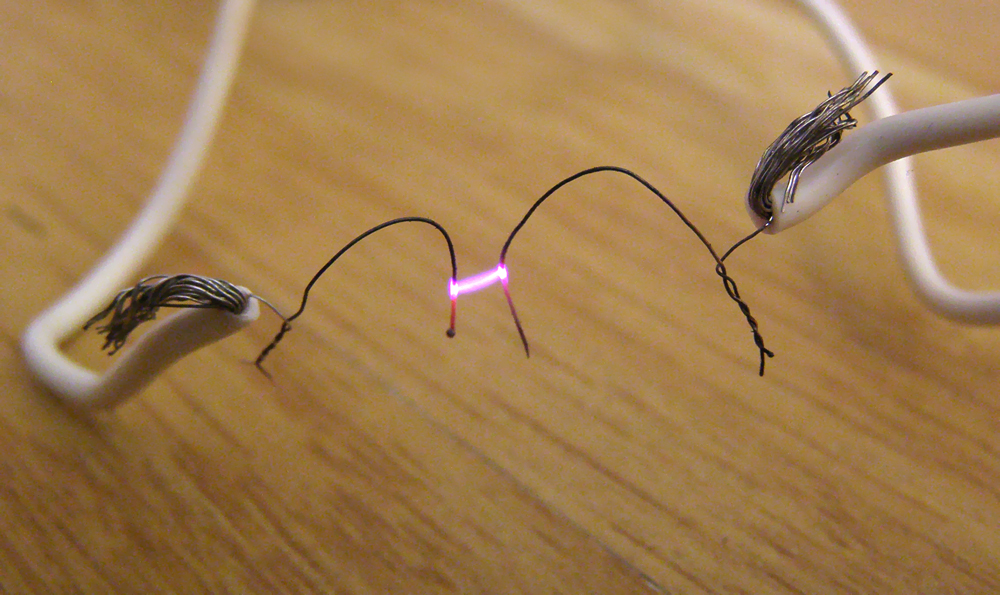| << Chapter < Page | Chapter >> Page > |

Using an ohmmeter, a student measures the resistance between various points on his body. He finds that the resistance between two points on the same finger is about the same as the resistance between two points on opposite hands—both are several hundred thousand ohms. Furthermore, the resistance decreases when more skin is brought into contact with the probes of the ohmmeter. Finally, there is a dramatic drop in resistance (to a few thousand ohms) when the skin is wet. Explain these observations and their implications regarding skin and internal resistance of the human body.
What are the two major hazards of electricity?
Why isn’t a short circuit a shock hazard?
What determines the severity of a shock? Can you say that a certain voltage is hazardous without further information?
An electrified needle is used to burn off warts, with the circuit being completed by having the patient sit on a large butt plate. Why is this plate large?
Some surgery is performed with high-voltage electricity passing from a metal scalpel through the tissue being cut. Considering the nature of electric fields at the surface of conductors, why would you expect most of the current to flow from the sharp edge of the scalpel? Do you think high- or low-frequency AC is used?
Some devices often used in bathrooms, such as hairdryers, often have safety messages saying “Do not use when the bathtub or basin is full of water.” Why is this so?
We are often advised to not flick electric switches with wet hands, dry your hand first. We are also advised to never throw water on an electric fire. Why is this so?
Before working on a power transmission line, linemen will touch the line with the back of the hand as a final check that the voltage is zero. Why the back of the hand?
Why is the resistance of wet skin so much smaller than dry, and why do blood and other bodily fluids have low resistances?
Could a person on intravenous infusion (an IV) be microshock sensitive?
In view of the small currents that cause shock hazards and the larger currents that circuit breakers and fuses interrupt, how do they play a role in preventing shock hazards?
(a) How much power is dissipated in a short circuit of 240-V AC through a resistance of ? (b) What current flows?
(a) 230 kW
(b) 960 A
What voltage is involved in a 1.44-kW short circuit through a resistance?
Find the current through a person and identify the likely effect on her if she touches a 120-V AC source: (a) if she is standing on a rubber mat and offers a total resistance of ; (b) if she is standing barefoot on wet grass and has a resistance of only .
(a) 0.400 mA, no effect
(b) 26.7 mA, muscular contraction for duration of the shock (can't let go)
While taking a bath, a person touches the metal case of a radio. The path through the person to the drainpipe and ground has a resistance of . What is the smallest voltage on the case of the radio that could cause ventricular fibrillation?
Foolishly trying to fish a burning piece of bread from a toaster with a metal butter knife, a man comes into contact with 120-V AC. He does not even feel it since, luckily, he is wearing rubber-soled shoes. What is the minimum resistance of the path the current follows through the person?
(a) During surgery, a current as small as applied directly to the heart may cause ventricular fibrillation. If the resistance of the exposed heart is , what is the smallest voltage that poses this danger? (b) Does your answer imply that special electrical safety precautions are needed?
(a) What is the resistance of a 220-V AC short circuit that generates a peak power of 96.8 kW? (b) What would the average power be if the voltage was 120 V AC?
(a)
(b) 14.4 kW
A heart defibrillator passes 10.0 A through a patient’s torso for 5.00 ms in an attempt to restore normal beating. (a) How much charge passed? (b) What voltage was applied if 500 J of energy was dissipated? (c) What was the path’s resistance? (d) Find the temperature increase caused in the 8.00 kg of affected tissue.
Integrated Concepts
A short circuit in a 120-V appliance cord has a resistance. Calculate the temperature rise of the 2.00 g of surrounding materials, assuming their specific heat capacity is and that it takes 0.0500 s for a circuit breaker to interrupt the current. Is this likely to be damaging?
Temperature increases . It is very likely to be damaging.
Construct Your Own Problem
Consider a person working in an environment where electric currents might pass through her body. Construct a problem in which you calculate the resistance of insulation needed to protect the person from harm. Among the things to be considered are the voltage to which the person might be exposed, likely body resistance (dry, wet, …), and acceptable currents (safe but sensed, safe and unfelt, …).

Notification Switch
Would you like to follow the 'College physics' conversation and receive update notifications?